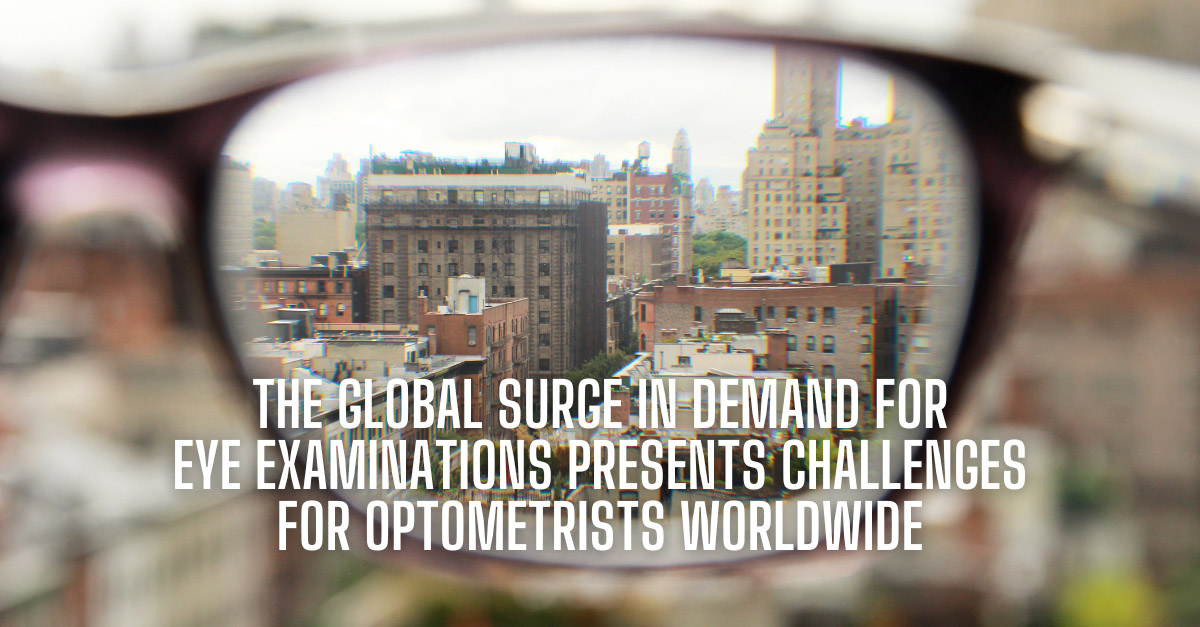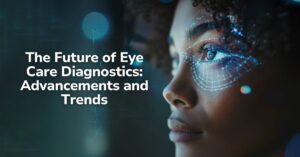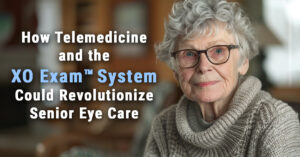Introduction
Because of various lifestyle factors and demographic changes, the increasing demand for eye examinations is a worldwide concern. This increased demand places additional strain on eye care professionals, particularly optometrists, who play a critical role in providing comprehensive eye care services. This article will delve deeper into the factors driving the global increase in eye examinations, as well as the challenges that optometrists face in meeting this demand.
Factors Influencing the Growing Global Demand for Eye Exams
Population Aging
According to the World Health Organization (WHO), the global population is aging, with the number of people aged 60 and older expected to double by 2050 (Ageing and Health, 2022). The risk of developing eye conditions such as age-related macular degeneration, cataracts, and glaucoma increases as people age (A. Smith Esen K. Akpek, 2013).
For example, age-related macular degeneration is a leading cause of irreversible vision loss in older adults, while cataracts account for nearly half of all cases of blindness worldwide (Vision Impairment and Blindness, 2022). As a result, the need for regular eye examinations among the elderly has increased, resulting in increased demand for eye care services globally.
Increase in Myopia Prevalence
Myopia, or nearsightedness, has become more common in recent years as a result of several factors, including increased screen time and decreased outdoor time (Holden et al., 2016). According to studies, the global prevalence of myopia has risen from 22.9% in 2000 to 34.0% in 2020. (Holden et al., 2016).
Furthermore, the prevalence of high myopia is increasing, which can lead to serious eye complications such as retinal detachment and glaucoma (Holden et al., 2016). This trend, combined with the world’s growing population, has resulted in a significant increase in the number of people requiring eye exams and corrective lenses.
Diabetes, High Blood Pressure, And Other Chronic Conditions Are More Prevalent
Myopia, or nearsightedness, has become more common in recent years as a result of several factors, including increased screen time and decreased outdoor time (Holden et al., 2016). According to studies, the global prevalence of myopia has risen from 22.9% in 2000 to 34.0% in 2020. (Holden et al., 2016).
Furthermore, the prevalence of high myopia is increasing, which can lead to serious eye complications such as retinal detachment and glaucoma (Holden et al., 2016). This trend, combined with the world’s growing population, has resulted in a significant increase in the number of people requiring eye exams and corrective lenses.
The Obstacles Facing the Eye Care Profession, Specifically Optometrists
Limitations on the Scope of Practice
The limitation in their scope of practice is one of the challenges that optometrists face in meeting the increasing demand for eye care services. Optometrists are not permitted in some countries to perform certain diagnostic tests or to prescribe specific medications.
These limitations can limit their ability to provide comprehensive eye care, affecting the eye care profession’s overall capacity to meet rising demand. Advocating for policy changes to broaden optometrists’ scope of practice is critical to addressing this challenge and improving global eye care delivery.
Access to Care Is Limited in Rural and Low-Income Areas
Rural and low-income areas frequently face a shortage of eye care professionals, limiting residents’ access to eye examinations (Cyr et al., 2019). The scarcity of optometrists in these areas makes meeting the growing demand for eye care services difficult.
Because of the geographical imbalance in the distribution of eye care professionals, innovative solutions are required to ensure that underserved populations receive adequate eye care. Telemedicine and task-shifting, which delegate certain responsibilities to non-specialist health workers, are potential strategies for improving access to eye care in these areas.
Instruction and Training
As the need for qualified eye care professionals grows, so does the demand for eye examinations. To provide high-quality eye care, optometrists must be properly educated and trained. However, the scarcity of optometry schools and the high cost of education can be significant deterrents for aspiring optometrists.
Furthermore, the rapidly evolving field of eye care necessitates ongoing professional development, which can be difficult for practicing optometrists to keep up with. Initiatives to establish more optometry schools and provide financial assistance to students can contribute to addressing the shortage of qualified eye care professionals.
Technology Integration
Technological advances have had a significant impact on the field of eye care, providing new diagnostic tools and treatment options. While these innovations have the potential to improve the quality of care, they also present challenges for optometrists in terms of staying current on new technology and incorporating it into their practice.
Devices like optical coherence tomography (OCT) and automated perimetry have transformed the diagnosis and monitoring of various eye conditions, but widespread adoption necessitates training and investment. Efforts to promote technology adoption, provide training opportunities, and make advanced diagnostic tools more accessible can help optometrists better serve their patients.
Patient Education and Information
Many patients are unaware of the importance of regular eye exams and the role that optometrists play in eye health maintenance. This lack of awareness can contribute to the underutilization of eye care services, particularly in communities with already limited access to care.
Public health campaigns and educational initiatives are critical for increasing awareness of the importance of eye care and optometrists’ roles in preventing, diagnosing, and treating eye conditions. These efforts can help to increase demand for eye care services and ensure that people get the necessary eye exams.
Partnership with Other Healthcare Professionals
Optometrists must collaborate with other healthcare professionals, such as primary care physicians, ophthalmologists, and other specialists, to meet the growing demand for eye examinations. This collaborative approach can aid in the identification of patients at risk for eye conditions and the provision of timely and appropriate care.
Fostering these relationships, however, can be difficult due to differences in practice models, reimbursement structures, and referral processes across countries. Creating standardized referral pathways and encouraging interdisciplinary communication can assist in overcoming these obstacles and improving patient outcomes.
Some Telemedicine Eye Exam Solutions are in Place, But More Are Right on the Horizon
Meeting the relentless global demand for eye examinations will take new approaches to deliver care, and new technologies will play an important role. First and foremost, expanding global wireless infrastructure will make providing telemedicine solutions into the farthest reaches of the globe more manageable.
Further, virtual eye examination technology companies such as Olleyes and Heru are changing how eye care is delivered to patients. With its XO Exam system, Xenon Ophthalmics is taking it a step further and producing a patented, medical-grade wearable headset exam system for providing aberrometry and visual field examinations remotely to just about anywhere in the world.
With the XO Exam system, doctors can see patients who cannot come to the office, allowing them to provide care to underserved communities remotely. Xenon Ophthalmics’ system is truly designed to address the global issue of meeting the surging global demand for eye examinations.
Conclusions for Eyecare Professionals
The growing global demand for eye exams poses significant challenges to the eye care profession, particularly optometrists. To meet this demand, optometrists must address their scope of practice limitations, improve access to care in rural and low-income areas, invest in education and training, stay current on technological advancements, raise public awareness about the importance of eye care, and collaborate with other healthcare professionals.
By addressing these issues, optometrists can play a critical role in meeting the growing demand for eye care services and promoting better eye health around the world.
To address these challenges, governments, healthcare organizations, and eye care professionals must collaborate to develop and implement policies and strategies. This could include investing in eye care infrastructure, broadening optometrists’ scope of practice, and encouraging interdisciplinary collaboration.
Furthermore, leveraging technology, such as telemedicine and artificial intelligence, can help improve access to eye care services while also improving overall care quality.
Furthermore, public health initiatives and community outreach programs should be developed to educate the general public about the importance of eye health and the importance of regular eye examinations. These efforts can help to increase demand for eye care services and ensure that people get the necessary eye exams, reducing the burden of eye diseases and improving global eye health.
Finally, the growing demand for eye exams poses significant challenges for the eye care profession, particularly optometrists. Optometrists, on the other hand, can play a critical role in meeting the growing demand for eye care services and ensuring better eye health for all by addressing these challenges and working collaboratively with other healthcare professionals and stakeholders.
A Comprehensive Approach to Providing Greater Access to Vision Care While Increasing the Quality of the Care Provided
XO Exam™ ABT (Aberrometry)
XO Exam™ ABT offers three critical subjective aberrometry tests (Digital Phoropter, Wavefront Aberrometry, and Retinoscopy) with greater accuracy, speed, and patient comfort than conventional optical exam equipment.
XO Exam™ VFT (Visual Field)
XO Exam™ VFT offers seven different visual field diagnostic tests and critical pupillary measurements with greater accuracy, speed, and patient comfort than conventional optical exam equipment.
References:
- Smith Esen K. Akpek, M. M. (2013, May 26). Overview of Age-Related Ocular Conditions. AJMC. https://www.ajmc.com/view/ace011_13may_agingeye_akpek
- Ageing and health. (2022, October 1). Ageing and Health. https://www.who.int/news-room/fact-sheets/detail/ageing-and-health
- Cyr, M. E., Etchin, A. G., Guthrie, B. J., & Benneyan, J. C. (2019, December). Access to specialty healthcare in urban versus rural US populations: a systematic literature review. BMC Health Services Research, 19(1). https://doi.org/10.1186/s12913-019-4815-5
- Holden, B. A., Fricke, T. R., Wilson, D. A., Jong, M., Naidoo, K. S., Sankaridurg, P., Wong, T. Y., Naduvilath, T. J., & Resnikoff, S. (2016). Global Prevalence of Myopia and High Myopia and Temporal Trends from 2000 through 2050. Ophthalmology, 123(5), 1036–1042. https://doi.org/10.1016/j.ophtha.2016.01.006
- Li, J. P. O., Liu, H., Ting, D. S., Jeon, S., Chan, R. P., Kim, J. E., Sim, D. A., Thomas, P. B., Lin, H., Chen, Y., Sakomoto, T., Loewenstein, A., Lam, D. S., Pasquale, L. R., Wong, T. Y., Lam, L. A., & Ting, D. S. (2020, September 6). Digital technology, tele-medicine and artificial intelligence in ophthalmology: A global perspective. PubMed Central (PMC). https://doi.org/10.1016/j.preteyeres.2020.100900
- Ma, W., Wang, G., Li, X., Wu, H., Liu, Z., Dong, N., & Li, C. (2020). Study of Factors Influencing Dry Eye in Rheumatoid Arthritis. Journal of ophthalmology, 2020, 5768679. https://doi.org/10.1155/2020/5768679
- Mills, K. T., Bundy, J. D., Kelly, T. N., Reed, J. E., Kearney, P. M., Reynolds, K., Chen, J., & He, J. (2016, August 9). Global Disparities of Hypertension Prevalence and Control. Circulation, 134(6), 441–450. https://doi.org/10.1161/circulationaha.115.018912
- Vision impairment and blindness. (2022, October 13). Blindness and Vision Impairment. https://www.who.int/news-room/fact-sheets/detail/blindness-and-visual-impairment
- Wong, T. Y., & Mitchell, P. (2004, November 25). Hypertensive Retinopathy. New England Journal of Medicine, 351(22), 2310–2317. https://doi.org/10.1056/nejmra032865
- Zheng, Y., He, M., & Congdon, N. (2012). The worldwide epidemic of diabetic retinopathy. Indian journal of ophthalmology, 60(5), 428–431. https://doi.org/10.4103/0301-4738.100542



